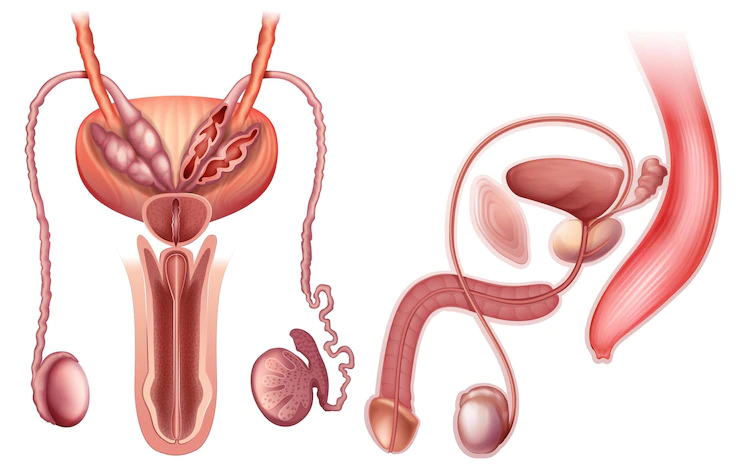What are the Symptom, Causes & Treatments of benign prostatic hyperplasia

Symptoms of Benign prostatic hyperplasia is an extremely common prostate problem in men and those assigned to males at birth. It causes the prostate to grow larger with age, and most people experience it to some degree. A person experiencing urinary problems may suffer from difficulties in urinating and experience an urgency to go more often. The management of such conditions involves the use of medicinal treatments, surgical interventions, and minimally invasive procedures.
Table of contents
What is benign prostatic hyperplasia & What are its Symptoms?
Benign prostatic hyperplasia (BPH) is a situation where the prostate enlarges in size. This gland is located below the bladder and in front of the rectum, usually about the size of a walnut. It also wraps around a part of the urethra.
The urethra serves as a passageway for urine and sperm to leave your body. When the prostate enlarges, however, the flow of both can be blocked due to the constriction of this tube.
BPH is not a form of cancer, but certain symptoms associated with it may signify a more severe underlying illness – including prostate cancer.
Benign prostatic hyperplasia & prostate cancer?
Studies have indicated that having BPH does not increase one’s probability of getting prostate cancer. However, the symptoms of both diseases are similar and it is possible to have both at the same time without the person realizing it.

It is recommended for all men aged 55 to 69 to have a prostate screening every year. This helps detect potentially harmful issues early when they are easier to treat & cure. Those who are Black or with a family history of prostate cancer should get checked even more regularly as they have an increased risk of developing the illness. Men with an increased risk of prostate cancer should begin having regular prostate screenings from the age of 40 to ensure early detection and treatment.
Who does benign prostatic hyperplasia affect?
BPH is a frequent issue among men, and people identified as male at birth. As people age, prostate enlargement is almost inevitable. Therefore, BPH occurs quite commonly as a result.
Symptom & causes of benign prostatic hyperplasia
Symptoms of benign prostatic hyperplasia?
Your prostate, which envelops your urethra, can become enlarged due to Benign Prostatic Hyperplasia (BPH). This can lead to obstruction in your urethra. One of the initial signs of BPH are:
- Difficulties such as a slow or weak urine stream, as well as difficulty initiating urination, can indicate an issue. In these cases, it is best to seek medical attention to determine the cause and the necessary steps to take.
- Struggling with sudden urges to urinate and episodes of leaks? Incontinence can be a frustrating issue – but there is help available. Seek support so you can gain control over your bladder and enjoy life more.
- If you find yourself having to get up multiple times during the night for restroom breaks, it could indicate difficulty in completely emptying your bladder.
Causes benign prostatic hyperplasia?
Healthcare professionals and scientists are still uncertain about the real source of BPH.
It has been theorized that as we age, testosterone levels in our bodies decline while estrogen remains stable. This may be the cause of an enlargement of the prostate cells. On that note, individuals who consume additional testosterone may end up triggering or worsening symptoms of Benign Prostatic Hyperplasia (BPH).
Elderly men and people assigned male at birth (AMAB) often have greater amounts of dihydrotestosterone (DHT). This form of testosterone is stronger than regular testosterone and can cause the prostate to enlarge.
Benign prostatic hyperplasia diagnosis
Your healthcare team will review your medical background, ask pertinent questions, and perform a complete physical. One element of the assessment may include a digital rectal examination.
During a digital rectal examination, your doctor will wear gloves and gently insert their finger into your rectum. They’ll examine the surface of your prostate to determine its size and feel for any hard spots, which might indicate cancerous growths.
Your doctor may order additional examinations such as a survey to determine the severity of your symptoms, a urine flow test to measure the speed at which you pee, a study to check how much urine is left in your bladder after urinating, and a cystoscopy for further monitoring.
Treatment
There are many options to choose from when it comes to treating an enlarged prostate, ranging from medication to minimally invasive therapies and surgery. To find the best-suited treatment option for you, it is important to consider several factors such as the size of your prostate, your age, your health condition, and the intensity of any symptoms or inconvenience you have been feeling.
If your symptoms are bearable, you may opt to delay treatment and keep an eye on your condition. In certain cases, the symptoms may subside even without medical intervention.
Medication
To address mild to moderate prostate enlargement, a doctor will most likely suggest medication as the primary form of treatment. This usually includes various options such as:

- Alpha-blockers offer relief by relaxing the bladder neck muscles and prostate muscle fibers, thus easing up the process of urination. Alpha-blockers such as alfuzosin, doxazosin, tamsulosin, and silodosin are commonly prescribed to men suffering from small prostates. These drugs typically produce positive results quickly.
- 5-alpha reductase inhibitors are used to reduce the size of a prostate gland. They work by blocking hormones that lead to growth and enlargement of the prostate. These medications can be beneficial for prostate health, as they can help manage symptoms and prevent future complications.
- Your physician might suggest you take a combination of an alpha-blocker & 5-alpha reductase inhibitor if either drug is not producing the desired results alone. This dual treatment can deliver better outcomes.
- Research has suggested that Tadalafil (Cialis), which is primarily used to treat erectile dysfunction, might also be a viable treatment for prostatic hyperplasia.
Surgery
Surgical treatment options are available to help alleviate Symptoms of Benign prostatic hyperplasia is an extremely common prostate problem in men and those assigned to males at birth. caused by the obstruction of your urethra from prostate enlargement. Such treatments range from minimally-invasive techniques to more comprehensive operations.
- TURP is a procedure in which a urologist inserts an instrument called a resectoscope through the urethra to view and remove tissue from the prostate. It’s an effective way to address certain issues with the prostate.
- A transurethral incision of the prostate (TUIP) is a procedure perform by urologists. Two small incisions are made in the prostate and bladder neck, which helps to widen the urethra & improve urine flow. This method can be highly beneficial and provide relief from urinary issues.
- Transurethral electrovaporization is a procedure by urologists, who use an electrode to heat the prostate tissue. This creates steam from cells located in the enlarged areas of the prostate, producing desired results.
- Urologists use GreenLight™ laser to evaporate enlarged prostate tissues. This highly effective procedure helps improve urinary symptoms while keeping pain and recovery time minimal.
Following a surgical procedure, most probably, you will be able to partake in your usual activities within a few days or even a week.
Minimally invasive treatments
BPH treatments have become increasingly less invasive and less damaging to healthy tissue, such a great advancement from traditional surgery. On top of that, most procedures are on an outpatient basis, meaning you can go home on the same day. Not only are these newer techniques cost-effective and have minimal side effects, but they also help you recover quickly. Yet, since these techniques are relatively new, there is a few information available regarding the long-term effects or possible complications.
A few examples of minimally invasive treatments include:
- Prostatic urethral lift is a common urological procedure that helps widen the urethra by separating the enlarged prostate lobes. A special Uro Lift device is in use in the same area by a urologist to help make urination more comfortable again.
- A water vapor therapy procedure may involve your urologist inserting an instrument into your urethra, then pushing it up to the prostate and releasing a needle into the prostate. This treatment is becoming more common as it can reduce pain and discomfort.
Common side effects of treatment may include frequent urination and some irritation while the prostate is healing up.
A minimally invasive approach typically ensures a quick recovery. You should be able to get back to your daily activities in a short time after the completion of procedure. Furthermore, you should experience relief from your symptoms within 3-6 weeks.
Takeaway
The post-treatment care for Benign prostatic hyperplasia is an extremely common prostate problem in men and those assigned to males at birth. may vary based on the method used. If you have know about laser ablation, transurethral needle ablation, or transurethral microwave therapy, it is advisable to restrict any heavy lifting activities or excessive exercise for at least a week. After an open or robot-assisted prostatectomy, it is recommended to restrict activity for the first six weeks to ensure proper recovery.
Products That We Suggest for you
ProstaStream – Prostate Health Supplement
ProstaStream is an all-natural prostate health dietary supplement for men. Additionally, prostaStream’s solution contains all-natural ingredients that are plant, gluten-free, and manufactured in a GMP facility. The solution is have FDA-approval, with no chemicals, or steroids.
To know more and purchase, Click Here
Prostacet- Support Prostate Health
The Prostacet Formula delivers key ingredients to nutritionally support a healthy prostate. Prostacet is an outstanding formula that supports prostate health with Serenoa repens which works to nourish this vital organ.
To know more and purchase, Click Here








Comment to this Article
Comments that encourage respectful conversation are welcomed at AGP Health n Beauty. Stay on subject, please. Comments that are aggressively promotional of goods or services or that include personal attacks, vulgar language, or other forms of abuse will be deleted. Which remarks break our comment policy will be decided at our discretion. (Anonymous comments are accepted; just leave out your name in the comment box. Although necessary, your email address won't be posted with your comment.)